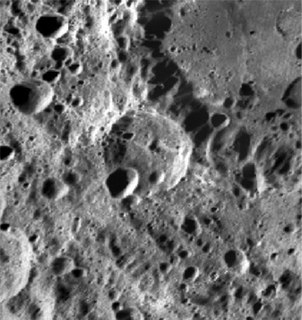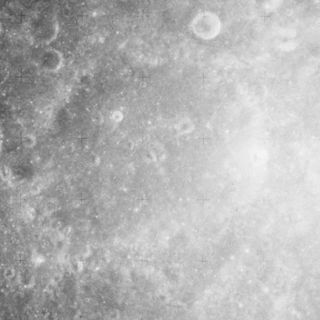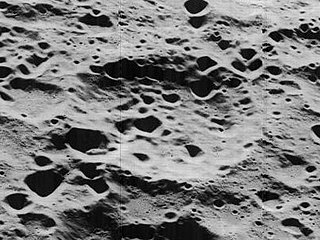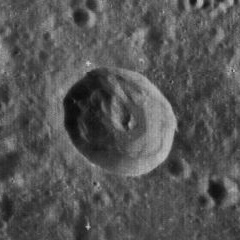
Balmer is the lava-flooded remains of a lunar impact crater. Only the heavily worn southern and eastern sections of the crater still survive; the remainder being overlaid by a lava flow that joins to the nearby mare. Balmer lies to the east-southeast of the crater Vendelinus.

Doppler is a lunar impact crater named for Christian Doppler that is located at the southern edge of the walled plain Korolev, on the far side of the Moon. To the east are the craters Das and Galois. Farther to the southwest of Doppler is Mohorovičić.

Boss is a lunar impact crater that is located along the northeast rim of the Moon's near side. Due to its location, the crater is viewed from the side by observers on the Earth, and its visibility is subject to libration effects.

Baco is a lunar impact crater that lies in the rugged southern highlands on the near side of the Moon. The rim and inner wall has been eroded and worn by countless minor impacts since the original formation of the crater. As a result, any terraces have been worn smooth and the rim is overlaid by several tiny craterlets. The interior floor is nearly flat, with no characteristic central peak at the midpoint and no small craters of significance.

Fizeau is a prominent lunar impact crater that is located on the far side of the Moon, in the southern hemisphere. Nearby craters of note include Minkowski to the west-northwest, and Eijkman to the southwest.

Borda is a lunar impact crater that lies between Santbech to the north-northwest and Reichenbach slightly further away to the south-southeast. It was named after French astronomer Jean-Charles de Borda. It has a low rim that is broken along the southeast by a smaller crater. The rim is intruded into by another small crater along the southwest side, and there is an irregular cleft along the northwest face. There is a central peak at the midpoint of the floor.

Belyaev is a lunar impact crater that is attached to the outer edge of the Mare Moscoviense, on the far side of the Moon. It is a worn formation with a small crater pair overlaying the southern rim, and several smaller craters across the relatively irregular interior.

Barringer is a lunar impact crater that is located on the southern hemisphere on the far side of the Moon. It is attached to the north-northeastern rim of the walled basin named Apollo, and lies to the southeast of Plummer. South of Barringer, on the floor of the Apollo basin, is the crater Scobee.

Barbier is a lunar impact crater that is located on the southern hemisphere on the far side of the Moon. It forms a matched pair with Cyrano to the north-northwest, and it lies to the southeast of the huge walled plain Gagarin. Southwest of Barbier is the crater Sierpinski, and to the southeast is the Mare Ingenii.

Buisson is a lunar impact crater that is located on the far side of the Moon. It is named after the French physicist Henri Buisson. Nearly attached to the southeast rim is the crater Vesalius. To the southwest is Einthoven. The rim of this crater is somewhat worn, and is lowest in the north. There is a low central ridge across the midpoint.

Demonax is a lunar impact crater near the southern limb of the Moon. This location makes the crater difficult to observe due to foreshortening. The crater is also illuminated at a very low angle, when it is in the sunlit side. Demonax lies just to the north of the crater Scott, one of the south polar formations. To the north-northwest is Boguslawsky.

Chappell is a lunar impact crater that is located on the far side of the Moon, in the northern hemisphere just to the north of the crater Debye. This feature is located in a heavily bombarded section of the surface, and much of the outer rim of the crater is overlain by many smaller craters. The northern rim in particular has been almost completely disintegrated, while small craters also overlie the rim to the northwest and southeast. What remains of the rim forms a rounded, somewhat irregular edge to the crater depression.

Chandler is a lunar impact crater in the northern hemisphere, on the Moon's far side. It lies to the southeast of the large walled plain D'Alembert, and southeast of the slightly smaller Chernyshev crater.

Chauvenet is a lunar impact crater that is located to the northeast of the prominent crater Tsiolkovskiy on the far side of the Moon. Less than one crater diameter to the northwest of Chauvenet is the crater Ten Bruggencate.

Fourier is a lunar impact crater that is located in the southwestern part of the Moon's near side, just to the southeast of the crater Vieta. To the northeast is the Mare Humorum. The rim of this crater is roughly circular, but appears oval when viewed from the Earth due to foreshortening.

Denning is a lunar impact crater that is located on the far side of the Moon. It lies about midway between the craters Levi-Civita to the south and Marconi to the north-northeast. About two crater diameters to the southeast is the huge walled plain Gagarin.

Dreyer is the remnant of a lunar impact crater on the far side of the Moon. It is located along the eastern edge of the Mare Marginis, about midway between the craters Ginzel to the north and Erro to the south-southeast. It was named after Danish-Irish astronomer John L. E. Dreyer.

Dunér is an old lunar impact crater that is located in the northern hemisphere on the far side of the Moon. It lies to the southeast of the crater Chernyshev, and west-southwest of the Perkin–Debye crater pair.

Evershed is a lunar impact crater on the far side of the Moon, named after the English solar astronomer John Evershed. It is located to the northeast of the larger crater Cockcroft, and to the north of the smaller Van den Bergh.

Schaeberle is an impact crater on the far side of the Moon. It lies to the northeast of the much larger walled plain Milne. Due north of Schaeberle is the relatively fresh crater Izsak, and an equal distance to the east-northeast lies Zhiritskiy.


























